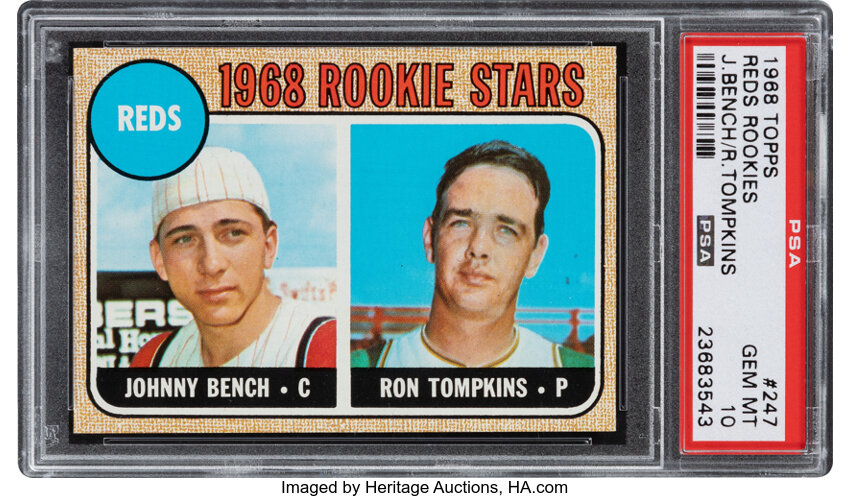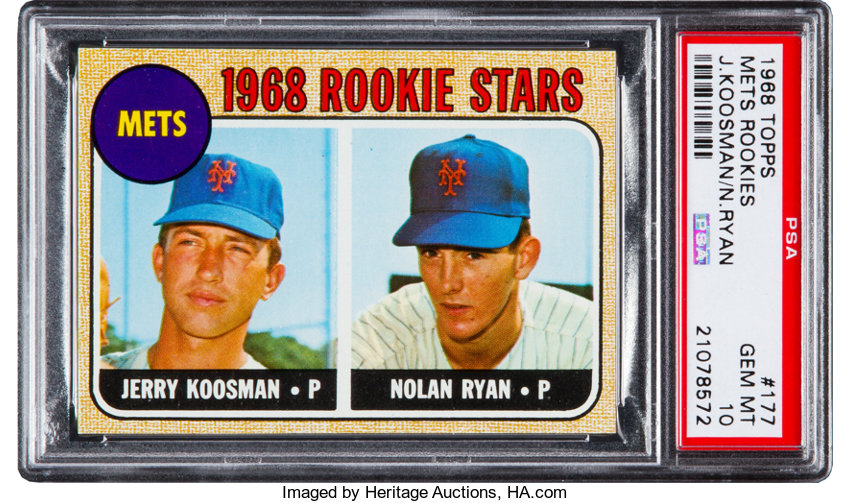Johnny Bench is considered by many baseball fans and collectors to have been the greatest catcher in baseball. Nolan Ryan is also considered to be one of baseball’s greatest pitchers ever. These two greats also share one thing in common – the 1968 Topps set as their split rookie cards. In honor of Johnny Bench’s birthday (December 7, 1947), Collectors Dashboard wanted to compare and contrast these two stellar rookie cards and what each of these great players contributed to baseball.
While there are some obvious things going for Nolan Ryan, the premium for a rookie that has to be paid for Ryan cards over Bench looks excessive in some aspects and looks reasonable in other aspects. Comparing the top pitcher to the top catcher isn’t Apples-to-Apples. Ryan also stretched his career another decade longer than Bench, and Ryan got to attract 4 different cities as fans rather than just 1 for Bench.
Collectors Dashboard evaluates high-end collectibles as an alternative asset class. This means collectibles are attracting the same capital that could have been invested into stocks or bonds. Many sports collectibles now cost thousands of dollars, and rookie cards of these two greats fit within that theme in being evaluated as alternative assets. Collectors with a passion to own these cardboard classics are also finding themselves pitted against investors who are only looking to make a profit in the future.
Stocks and bonds have no guaranteed profits. If that is true, then baseball cards should be expected to have no guarantees either. And while card prices have risen handily over time, many aspects of the card market have faced very painful trends after the zenith in early 2021.
Another issue to keep in mind is that both of these rookie cards are easily in the Top 10 Baseball Rookie Cards of the 1960s. It remains unknown if Thurman Munson would have rivaled Johnny Bench over the next few years after his death, but Munson cards have seen some very selective rookie premiums that have caveats and are astronomical. Carlton Fisk played in 24 seasons, but Bench’s older cards are generally worth far more than Fisk’s outside of the rookie and second years.
While it would be easy to say that Bench is undervalued, perhaps this is more of a case of being underappreciated by the hobby when it comes to card values. The stock market cannot use relative valuations in a straight line for major peer stocks within a sector, so it is not expected that the best pitcher and best catcher of the same generations could have direct valuation comparisons. That said, here is a stab at it.
BENCH vs. RYAN CAREER HIGHLIGHTS
Bench’s career was from 1967 to 1983 and the only team he played for was the Cincinnati Reds. His predominant role was as catcher. Bench also filled in elsewhere as his career advanced and as the position of being a catcher takes its toll on the body. He also was on every All-Star team from 1968 through 1980. Bench was MVP twice, won 4 National League pennants and has 2 World Series championships. He is also third on the all-time home run list at 327 (shy of rival Carlton Fisk, and later Piazza).
Nolan Ryan’s career spanned 27 seasons and he was slow to develop. He was not a stellar pitcher with the Mets, but after joining the Angels in 1972 his wins and strikeout pitches began to skyrocket. He became a Houston Astro in 1980 and then joined the Texan Rangers in 1989. His career had “only” 8 All-Star appearances and despite his strikeout prowess he never once won the Cy Young Award. Ryan’s only World Series team was the 1969 Mets.
BENCH vs. RYAN CAREER STATS
Johnny Bench was the master behind the plate, but he was also a solid hitter. He led the National League in homers twice and led the league in runs batted in 3 seasons. Defensively he won the Golden Glove Award 10 times. Bench was also a master at pitch framing and those with an ambition to steal second lost out to his fast and accurate throws. His .267 career average is solid for a catcher, but his .476 slugging rate is solid enough for any position. Bench’s 17 seasons yielded 2,048 hits, 381 doubles, 389 homers and 1,376 runs batted in.
Ryan ended up with an all-time strikeout leadership with 5,714 strike-outs. The only other player to come within 1,000 strikeouts of that was Randy Johnson at 4,875. Roger Clemens is third with 4,672 Ks and Steve Carlton is fourth with 4,136. They all played more than 20 seasons. Ryan ended his career with 324 wins and 292 losses.
BENCH vs. RYAN ROOKIE CARDS

When it comes to rookie cards, neither Nolan Ryan nor Johnny Bench rookie cards would be classified as rare. What is rare are the rookie cards in the highest grades. And in that department, Nolan Ryan rookies are more scarce at the highest grades and will command the highest prices. (Images provided by Heritage Auctions)
Johnny Bench (#247) has 8,012 regular graded examples by PSA, and PSA has another 510 graded examples at the “+” level and another 816 at the Qualifier level. All in that is 9,338 graded rookie cards by PSA alone. But in the highest grades, his count is as follows:
- PSA 10 has 15 examples
- PSA 9 has 212 examples
- PSA 8.5 has 58 examples
- PSA 8 has 1,033 examples

Nolan Ryan (#177) has 10,676 regular graded examples by PSA. Then PSA also has another 866 graded examples at the “+” level and another 1,495 at the Qualifier level. All in that is 13,037 total graded rookie cards by PSA alone, more than 39% more than the number of Bench rookies. But in the highest grades, his count is as follows:
- PSA 10 has only 1 example
- PSA 9 has only 66 examples
- PSA 8.5 has only 36 examples
- PSA 8 has just 740 examples
SGC’s population report for Johhny Bench is also smaller than Nolan Ryan’s graded examples. Bench’s card with 1,781 total graded examples. Of that, there are only 2 listed as SGC 10 and 1 example at 9.5. Bench has 33 examples at SGC 9, 42 at SGC 8.5 and 91 examples at SGC 8.
SGC’s population report for Nolan Ryan is also much larger than Bench’s rookie card with 2,731 total graded examples, more than 53% higher than Bench’s total graded population. Of that, there are only 2 listed as SGC 10 and 4 examples at 9.5. Ryan has 21 examples at SGC 9, 36 at SGC 8.5 and 90 at SGC 8.
BENCH vs. RYAN CARD PRICE SALES
Higher populations of graded cards do not necessarily mean that a card was more rare as much as it means that people who own the card are much more likely to get the card graded because there is a known value no matter what the grade. Think of the 1955 Topps rookie card of Sandy Koufax. As a rookie, he was an unknown player when it was printed and now it has the highest graded population of all 1955 Topps cards.
With a higher population of PSA 10 (and higher prices in general), we have seen multiple sales of PSA 10 cards of the Johnny Bench rookie. All of those were from Heritage Auctions with different certification numbers, with sales by date as follows: $93,000 (11/20/21); $108,000 (7/27/21); $87,000 (5/10/21); and $72,000 (2/27/21). The last PSA 10 sale of $72,000 had the same certification number that had previously sold for $40,590 via Goldin Auctions on 11/1/20 (not a bad profit at all for less than 4 months), and Heritage had sold the same card certification number for $33,600 on 2/25/20. The average of the last 3 sales of PSA 9 was $5,600 (rounded).
With Nolan Ryan only having 1 example in the perfect PSA 10, the only sale we have seen was on 8/28/2020, for $600,000.00 through Goldin Auctions. We have seen more PSA 9 sales in 2021, as follows: $136,530 (10/27/21, Goldin); $125,582 (10/13/21, Memory Lane); and $62,730 (5/24/21, Goldin).
AND IN MORE AFFORDABLE/COLLECTABLE PRICES
In just looking at the last sales by grade, the prices remain much higher for Ryan (or more affordable for Bench). We have looked at the last 3 sales at each grade and created an average price (rounded) based on those for each:
- BENCH PSA 8.5 at $3,000 versus RYAN 8.5 at $19,750 … Ryan premium 6.6X
- BENCH PSA 8 at $1,530 versus RYAN 8 at $8,700 … Ryan premium 5.7X
- BENCH PSA 7 at $673 versus RYAN 7 at $2,752 … Ryan premium 4.1X
- BENCH PSA 6 at $338 versus RYAN 6 at $1,500 … Ryan premium 4.4X
- BENCH PSA 5 at $272 versus RYAN 5 at $1,200 … Ryan premium 4.4X
- BENCH PSA 4 at $178 versus RYAN 4 at $735 … Ryan premium 4.1X
IN THE END….
How you value cards is up to each collector to decide. Most collectors will take the top home run hitters over the top pitchers, but almost everyone can agree that the top pitchers are going to be more desired than the top catchers. And just because the multiple a collector has to pay for one player over another is much higher does not mean that the ratios have to shrink. There are no assurances at all that any of these price differentials will change at all.


